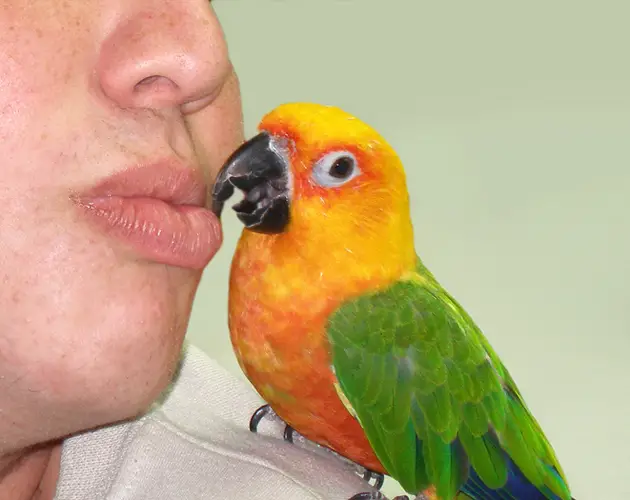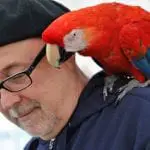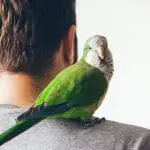What do pet owners love to do with their pet birds? They love to kiss them! Pet birds like parrots and parakeets love the attention they get from their owners. Pet owners know that by interacting, talking, and treating their pet birds like family, like children, they will develop a well-rounded behavior.
Pet birds need constant interaction to improve their behavior and, of course, to learn new tricks. Pet owners show their affection with kisses, but there is a safe way to kiss your pet bird. Find out about how to kiss your pet parrot or parakeet with these practical tips.
Not all birds want to be kissed!
Before you start kissing or showering your pet bird with affection, you must first understand the behavior of your pet. Despite being easy pets, not all birds want to be kissed! Some birds prefer to be alone, while some just prefer the company of fellow birds or birds of the same species. However, some birds are more interactive and are likely to warm up to affection showered by their pet owners. Just like parrots and parakeets.
A pet owner who has a parakeet describes her feathered pal as one of her kids. The bird can talk and can respond to calls and music. And most of all, they love to be kissed.
Take note that a pet bird may not immediately respond to kisses, especially when it is just from the wild or from a pet store. Just like training it how to sing, talk, and do other tricks, kissing requires time and dedication. Also, training your pet bird how to kiss can be easy or can be a headache. Some bird species will readily respond to training while some can take a long time to catch on.
Learn how to handle your pet properly
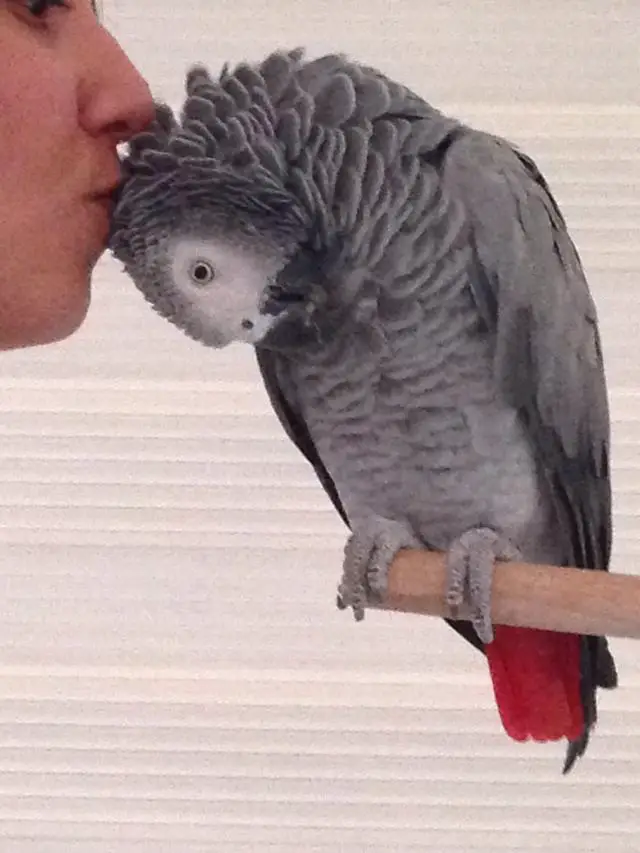
When training birds or any pet for that matter, you must first instill trust. If your pet doesn’t trust you, then your training won’t take off. Before you go on kissing your pet, you must learn how to handle it well.
Use a thick, leather glove to protect your hands. If you have a parrot or a parakeet, open the cage and gently stroke its back and then its head. Make it feel comfortable with your gentle touch. The key to this trick is to never rush it. What would you feel if someone wanted to kiss you? Your parrot is scared if you were to do the same!
After many tries of petting your bird, place food on your hand so you can encourage it to perch. Let it feed on your hand first, and then eventually, try to lift it by offering your hand. Your pet bird will soon realize that your hand is safe to be in and will have no qualms in being on your hand.
Again, don’t rush; just let it get used to your hand first. As it stays on your hand, stroke its head and its body. Offer food and a lot of affectionate words.
And once your pet is very comfortable with your handling, you may now move closer and kiss its beak. If your bird is comfortable with you and it trusts you, it won’t move away, but if it needs more time, withdraw your face and just proceed with stroking it and giving it treats. Try kissing it again later.
Kiss only the beak

The most important safety tip is to just kiss your pet on the beak. Don’t kiss it in the mouth and certainly don’t allow it to peck or lick your mouth or lips. Birds carry diseases that can be harmful to humans. Your pet may look asymptomatic, but it may be a carrier of a virus or bacteria that can make you sick. Also, it’s improper to kiss a bird from its mouth!
Another reason why you should only kiss the top of the beak, especially a parrot new to this activity, is that your pet may still be unsure of your intentions and might bite you. Kissing the top part of the beak will avoid this.
Stroke your pet bird

Your pet will love to be held and stroked after your kiss. You will soon see that after this trick, it will look for your hand to pet it and hold it. You may also want to give it some treats so it can associate this affectionate behavior with food.
Teach your pet bird new tricks
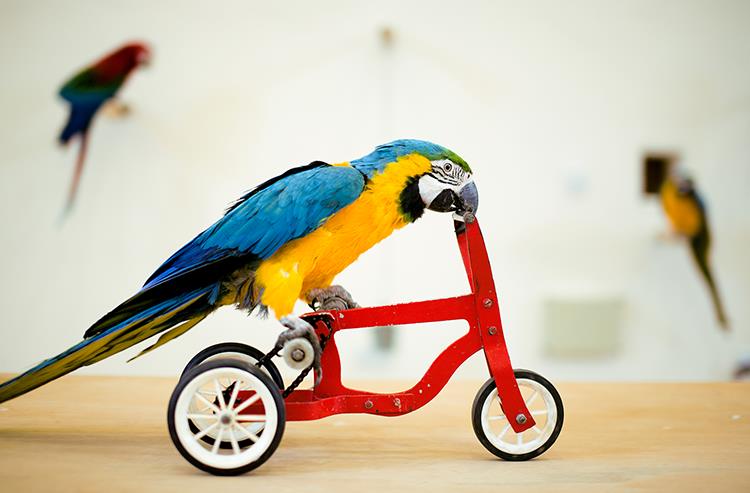
Aside from kissing and petting your pet, you can also teach your pet some new tricks. Teaching your pet parrot new tricks is a great pleasure for you and also for your pet. But take note that this is not merely a performance because your pet views this as social interaction. This will help improve his behavior, his tameness, and his overall well-being.
If you have one parrot in a cage, then this interaction is necessary. Your pet needs you because you are its closest friend. These tricks will be a way to improve your friendship and bond.
Just like learning how to kiss, you must find a place where you can quietly teach your pet bird new tricks. It is best to find a spot that’s away from the bird’s cage and also away from any kind of distraction. You must have a branch or a perch nearby, and this is where you will teach your pet parrot tricks. You must also have a good supply of treats to help you train your pet parrot well.
As much as possible, keep training sessions short. You must watch your pet closely, and as soon as he stops or loses interest, pauses the training.
· Teach your pet how to wave
Waving is a very basic trick that your pet can learn. It is simple to teach but may not be that simple for all birds. Some birds will easily follow this trick, while some can take time.
To start, place your pet on its perch and say the command “wave!” As you say the command, take your pet’s hand, hold it up, and shake it. Give it a treat.
Afterward, say the command again and repeat the steps. Give your pet a treat. The third time, say the command and your pet will surely lift his hand and move it as you did a while ago. If he does this without your help, then he has learned the trick. Give him a piece of treat. Repeat the command, and surely, your pet will repeat the response for the given command. Practice this time and again even without any treats. Instead of a food treat, pat your bird on the head or kiss him on the beak.
· Teach your pet how to turn around
Now a more complicated trick is teaching your pet to turn around. Your pet may not be comfortable doing this on a perch, so you may place it on a stable surface like a table or on the floor, whatever is accessible to you.
Your bird must be looking at you when you say “turn around” or “around.” Then, use your hands with a piece of a treat to move the bird in its place. Naturally, the bird will move in response to the treat. Move your bird by waving the treat until he has made a full rotation. After it has done the trick, offer the treat.
Repeat the command “turn around” or “around” and again, wave the treat high and guide it until it makes a full circle. Give the treat in the end. On the third time, say the command and raise your hand, but this time without a treat. Pretend to have it in hand by closing your palms but still guide the bird into making a rotation. After he has turned around, praise it, scratch and pat it on the head. Finally, say the command again and watch your bird move on its own. Be sure to give it a treat after he has made a complete circle.
· Teach your pet how to take a bow and play dead
Taking a bow is similar to playing dead because your pet will assume a lying down position when you command him. To start training, your bird must be on a flat surface or on the floor to follow through. Say the words “play dead” or “bang-bang.” Say this command dramatically and quickly with a piece of treat on hand. You will lead the bird from a standing to a lying down position by gently nudging it downwards while still maintain your hand on the treat. Once your pet’s body and head touch the floor or the table, let him stay that way for a few seconds and then let him up to give the treat.
Do this the second time and follow all the steps. Say “play dead” or “bang-bang” and have a treat on your hand and proceed with helping your pet lie down. Wait a few seconds and let it up to receive the treat. Repeat another time, and this time your pet has to lie down without your help. This is a complicated routine and must be repeated again and again until your pet gets it. Offer his most favorite treat so he will be more motivated.
· Teach your pet how to fetch things
Fetch is a traditional dog trick that can also be learned by birds, with the right motivation. You see, birds like parrots are not really into getting stuff and retrieving stuff for you as your pet dog will. But with a lot of patience and armed with your pet’s most favorite treats, he will be learning how to fetch in no time.
To start, place your pet on the floor or a level table so you and your pet can look straight in the eye. Use a small ball with a handle or a part that he can hold with his beak for the trick. Let him see the ball and take an interest in it by rolling it, holding it high or bouncing it and then, say the command “fetch.” Throw the ball a few inches from its back. He will surely take the ball and bite it in interest but slowly and gently guide it back to you by holding the ball gently. Take the ball and give him a treat.
Repeat the command by again taking the ball and letting him know you have it. Say “fetch” and throw the ball in the same direction. As your pet holds the ball with his beak, lead it towards you, and then take the ball. Offer a treat once more.
The third time, let him know you have the ball and say the command. Throw the ball and watch him take the ball, and walk back to you even without your guidance. After successfully taking the ball from your pet, offer the reward.
Repeat the routine several more times but each time, change from giving a treat to giving him verbal praises, a lot of pats and hugs.
· Teach your pet how to sit on your shoulder
Before you proceed with this trick, repeat all the tricks your pet has learned each day. Take note that you should teach your pal new tricks each day, don’t rush training. Just repeat all the commands he has learned so far before proceeding with the next.
So, to teach your pet to sit still on your shoulder is a very important trick. Why is it so? Because if you can do this, then your pet can comfortably sit and be with you no matter where you go. But you cannot start this trick without your pet’s full trust in your handling. Tricks on the table and the floor are different things than handling it as you walk or stand.
To start, make your pet stay on your arms first. To do this, take a few pieces of his favorite treat and place it in your open hand. The bird must be in front of you and is aware that you have some treats in your hand.
Open your hand and let him climb up it. Slowly place him back on the table after a few minutes. Repeat the activity and let him see that you have his favorite treats in your hand. He will instantly move towards you and just let him eat. Slowly place your pet on your arm and keep a steady pace. Talk to your pet, stroke it, and pet it so it can be distracted. If your bird is jittery and seems unsure about the activity, set him down again. Repeat after a few minutes.
Once your pet is comfortable on your arm, you may now place it on your shoulders. But on the first try, don’t stand up, just sit on your chair. Don’t mind your pet, and just do things as if there’s nothing new. You can read, check your phone, watch TV or use the computer. You’ll notice that he will simply stand or sit still and may soon become more comfortable as evidence of his loosening grip. After a few minutes, remove your pet from your shoulders by luring him with some food to go down to your arm and then your hand. Do this very carefully, and when he’s down the table, give it some treats, praises, and pats.
Repeat this trick and watch how confident your bird is moving from your hand, arm, and to your shoulders. Once he is relaxed and you can move around with him on your shoulders, you may now stand and move about. Naturally, it will try to move and may even want to fly away but coax it with food.
Kisses can cause parrot fever
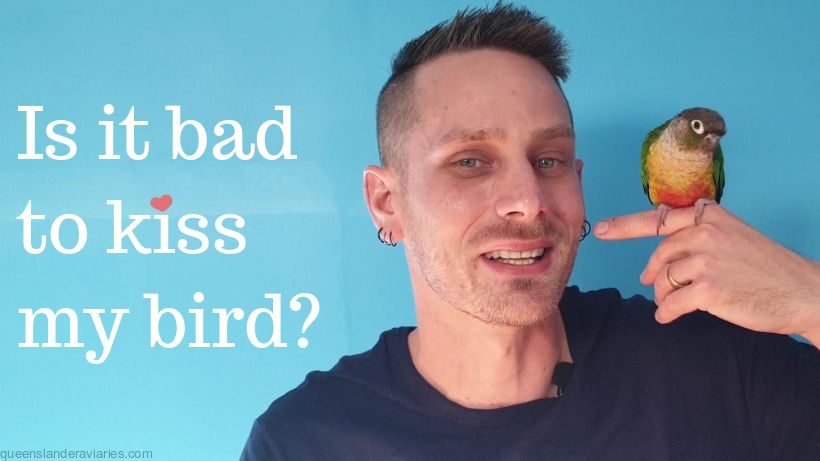
As we learn how to kiss birds safely, you also have to learn a very important fact about bird kisses, and that is about parrot fever. Learn all about parrot fever, how to spot birds with parrot fever, and how to protect yourself from this disease.
Parrot fever is a very rare infection due to the Chlamydia psittaci, which is a bacteria. Also known as parrot disease, the CDC or Centers for Disease Control and Prevention revealed that there are less than 10 cases of parrot fever in humans every year from 2010. But there are also undiagnosed cases or unreported illnesses because parrot fever symptoms may be similar to some respiratory illnesses.
This disease comes from birds, especially domesticated and wild parrots, as well as other birds related to parrots. The sickness is passed from sick birds to humans especially their human carers.
Humans may also get the disease by accidentally breathing in some fine particles from the infected parrot’s urine, poop, and other secretions. If an infected bird bites you with its beak if you kiss your bird on the beak or touch its beak with your hands.
Humans may also get the disease from an infected person, but this may be rare. You can become sick by inhaling the droplets that an infected person coughs.
For any of these symptoms on your pet, take it to the vet immediately. Early treatment is the best solution, so you must be attentive to what your pet is telling you.
Treatment is a round of antibiotics to kill the bacteria. Also, symptomatic treatments are done, such as medicine for fever, pains, and diarrhea. Loss of body fluids must be controlled at once because your pet may die of dehydration. He will likely be admitted to a hospital for further treatment and for intravenous treatment to stop dehydration.
You need to visit your doctor for possible parrot fever infection. Other parrots or other bird pets must also be taken to the vet for checkups and possible treatment.
Conclusion
If you must kiss your pet parrot, do so safely. Although this is a sign of affection, your pet may misinterpret this gesture as a sign of hostility. This is why you need to develop the trust of your pet before you proceed with this trick. Parrot kisses are a sign of a close bond between a parrot and his master, but be careful not to get parrot fever from infected birds. At the first sign of parrot fever, consult your vet so your pet can get reliable and early treatment. Stay safe when kissing your pet, as well as performing other parrot tricks.
